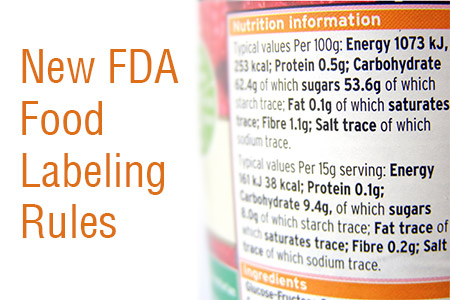A report published by the U.S. Food and Drug Administration (FDA) Center for Food Safety and Applied Nutrition found that 77 percent of the adults surveyed use the Nutrition Facts label at least a few times while buying food products. The 11th edition of the FDA Health and Diet Survey is based on the data from 2,480 participants, who were interviewed over the phone about their respective understanding of the nutrition claims and the use of nutrition labels, the general attitude towards nutrition, health issues, and purchasing practices.
The FDA had issued a final guidance on November 19, 2015, outlining its recommendations for food companies on the voluntary labeling of foods as to whether a food is derived from genetically engineered (GE) plants (final GE labeling guidance), or not. The FDA has now revamped the nutrition labels. The following sections will give you a scoop of the details regarding what is involved and how and when it can affect you.
Some of the new format requirements are:
- The fonts for “Serving size”, “Calories” and “Servings per container” will have to be increased a bit, though the general feel of the label can be kept the same. The serving size and calories will also need to be in bold type face.
- Required minerals and vitamins will have to be mentioned in actual quantity (in mg) in addition to the percent Daily Value. Showing of gram amounts for optional nutrients is voluntary.
- A new footnote
- There are also some new content requirements; which include:
- “Added sugars” has to be shown in grams and as a percent Daily Value, needs to be broken out and must be shown as a separate line under carbohydrates.
- Vitamin A and C are no longer mandated nutrients; however, calcium and iron will still be required. Vitamin A and C have been replaced by Vitamin D and Potassium.
- “Calories from Fat” is no longer considered as a useful information. Therefore, it would not be shown going forward.
Food Labeling Claims
Food Labeling Claims can be a very profitable marketing tool for your product in the market. These claims can set your product apart from all other products which co-exist in the market, with promises for better nutrient-rich benefits. It has been seen that a lot of marketing departments go ahead and make these claims without understanding the regulations which must be adhered to when making such claims. There are regulations that safeguard the consumer with allowable and unallowable claims as well as supporting disclaimers which need to be in place. Therefore, it is essential to learn when and how a claim can be made on a food package.
Join this conference “FDA Food Labeling Claims – Understanding the Advantages and the Risks of Claims” by expert speaker Natasha Rowley-Phipps to review the types of claims with an in-depth review of the regulations. Get insights on claims in the marketplace with examples and review case studies of claims with the enforcement actions taken by the FDA.


